Electric Griffith
Discussion
ChimpOnGas said:
Sardonicus said:
Not sure I would be happy about a pressure vessel containing 5,000 psi in my mode of transport  150 psi goes off like a grenade as is and will break & pull limbs out or worse still death , I dont care what construction the cell is accidents happen and running figures like that so does the possibility of failure
150 psi goes off like a grenade as is and will break & pull limbs out or worse still death , I dont care what construction the cell is accidents happen and running figures like that so does the possibility of failure 
I'm with you mate, but you have to consider a pure oxygen internal combustion engine conversion would really be no different to a compressed natural gas conversion, and there are literally hundreds of thousands of CNG vehicles in the world  150 psi goes off like a grenade as is and will break & pull limbs out or worse still death , I dont care what construction the cell is accidents happen and running figures like that so does the possibility of failure
150 psi goes off like a grenade as is and will break & pull limbs out or worse still death , I dont care what construction the cell is accidents happen and running figures like that so does the possibility of failure 

CNG must be compressed at 2,900 to 3,600 psi to turn from a gas into a liquid.
Do you have a set of oxy/acetylene bottles in your workshop?
If so much like my LPG cylinders in my TVR while the acetylene cylinder will only have a pressure of 250 psi, the oxygen cylinder is at 2,200 psi, so the chances are you've spent much of your working life stood right next to a 2,200 psi cylinder
 ..... and you haven't died yet
..... and you haven't died yet 
 going slightly off topic here I honesty get leccy vehicles for short journeys (to the shops train station etc) I really do
going slightly off topic here I honesty get leccy vehicles for short journeys (to the shops train station etc) I really do  inc my daily short commute its just all the other times when we do those bigger journeys I want some enjoyment and batts are not that, however I do like the alternative fuel thing and it may be too late but I do believe they should of jumped on LPG all that time back
inc my daily short commute its just all the other times when we do those bigger journeys I want some enjoyment and batts are not that, however I do like the alternative fuel thing and it may be too late but I do believe they should of jumped on LPG all that time back  at OE manufactured levels of refinement (no piggy back's) they would of nailed its use way back in the noughties especially dual fuel, I know some tried GM etc
at OE manufactured levels of refinement (no piggy back's) they would of nailed its use way back in the noughties especially dual fuel, I know some tried GM etc The basic issue is what system can you use to hold huge amounts of power safely, and it simply breaks down into how many joules of energy to can store in a given weight of fuel storage. Batteries however good are limited to how reactive the base metals to store energy, and lithium is pretty lively stuff, but petrol holds about 17 x more power, whilst hydrogen in liquid form is about the same as petrol. Of course an electric motor is hugely more efficient than the ICE, which is why it stands a fighting chance against a system that throws 80% of its energy out via the radiator.
Going back to a liquid fuel from the atmosphere for a moment, the argument against using it would need huge amounts of sun energy to produce, but then once its burnt its back as waste heat and CO2 anyway, but follow it to its logical conclusion, cycle is now a closed loop, so the overall amount of heat and CO2 wont go up plus we get to keep our beloved ICE.
Going back to a liquid fuel from the atmosphere for a moment, the argument against using it would need huge amounts of sun energy to produce, but then once its burnt its back as waste heat and CO2 anyway, but follow it to its logical conclusion, cycle is now a closed loop, so the overall amount of heat and CO2 wont go up plus we get to keep our beloved ICE.
I thought the 'Air to Fuel' video was very interesting - hadn't seen that before and does look like a possible silver bullet for the CO2 problems of this world. I guess the bottom line is how many kWH of renewable electricity are required per litre of petrol substitute and therefore how many hectares of PV panels are required in desert regions and do the economics stack up,,,, would be nice to keep driving our TVR's guilt free - even doing our bit to stock up global CO2 levels!!
Personal opinion coming up so don't flame me!
When I think of the brand TVR, especially how it was marketed last time around in the 2000s, it was very much 'the rebel'.
Not following the herd and saying no to legislation like traction control etc.
The brand has a reputation of sticking one finger up.
Going electric is following the herd.
I'm comfortable with other sports car marques like Jaguars going electric (NEW Jaguars I must stress; an electric E-type was unforgivable) as the slogan 'grace & pace' is a perfect fit.
TVR has a USP as the 'blue collar workers sports car' - and I like that. With dirty fingernails I separate myself from estate agents in their Porsches.
Electric has a smart and presentable cleanliness about it and in my view, it simply doesn't fit the brand.
Go electric and you lose that USP and you find yourself competing with people you don't want to compete with. Surely internal combustion can exist in low volumes for club events and track days?
In the grand scheme of things, what is the amount of miles covered annually by all our TVRs? We are not exactly killing the planet here.
Sadly however, I don't know how long this can last - but TVR have a history of rule bending to get away with things. They got away with no ABS or airbags later than everybody else!
For example, didn't the Caterham 7 offer final home assembly (basically screwing the badges on to register as a kit car to dodge VAT etc.)...... Where rules exist they can be circumvented. Ask Adrian Newey. Or Volkswagen.
When I rumble down my high street, sometimes a group of young lads will instantly shout TVR! That's amazing considering the brand went defunct the same time they were born. They are tomorrows customer. Would they be as excited over a Tesla? Ask yourself why not.
I've probably only got 35 years left on this planet, so if they can string it out that long, i'll be happy. Then millennials with clean fingernails can decide where it goes next.
Here's to making noise and smells (in moderation if needs be).
JKM
When I think of the brand TVR, especially how it was marketed last time around in the 2000s, it was very much 'the rebel'.
Not following the herd and saying no to legislation like traction control etc.
The brand has a reputation of sticking one finger up.
Going electric is following the herd.
I'm comfortable with other sports car marques like Jaguars going electric (NEW Jaguars I must stress; an electric E-type was unforgivable) as the slogan 'grace & pace' is a perfect fit.
TVR has a USP as the 'blue collar workers sports car' - and I like that. With dirty fingernails I separate myself from estate agents in their Porsches.
Electric has a smart and presentable cleanliness about it and in my view, it simply doesn't fit the brand.
Go electric and you lose that USP and you find yourself competing with people you don't want to compete with. Surely internal combustion can exist in low volumes for club events and track days?
In the grand scheme of things, what is the amount of miles covered annually by all our TVRs? We are not exactly killing the planet here.
Sadly however, I don't know how long this can last - but TVR have a history of rule bending to get away with things. They got away with no ABS or airbags later than everybody else!
For example, didn't the Caterham 7 offer final home assembly (basically screwing the badges on to register as a kit car to dodge VAT etc.)...... Where rules exist they can be circumvented. Ask Adrian Newey. Or Volkswagen.
When I rumble down my high street, sometimes a group of young lads will instantly shout TVR! That's amazing considering the brand went defunct the same time they were born. They are tomorrows customer. Would they be as excited over a Tesla? Ask yourself why not.
I've probably only got 35 years left on this planet, so if they can string it out that long, i'll be happy. Then millennials with clean fingernails can decide where it goes next.
Here's to making noise and smells (in moderation if needs be).
JKM

Now you guys have reminded me, I must pop across the road, get my classic out of the "garage" and park it in a field for the day, just like we do with our TVRs on summer weekends.
This classic is environmentally friendly, runs on bio fuel, and only produces a barrow full of bio-degradable emissions a day (if you ignore the 50+ farts).
All it needs is an annual service and its, errr, "wheels" balancing 8 times a year.

jay-kay-em said:
Personal opinion coming up so don't flame me!
When I think of the brand TVR, especially how it was marketed last time around in the 2000s, it was very much 'the rebel'.
Not following the herd and saying no to legislation like traction control etc.
The brand has a reputation of sticking one finger up.
Going electric is following the herd.
I'm comfortable with other sports car marques like Jaguars going electric (NEW Jaguars I must stress; an electric E-type was unforgivable) as the slogan 'grace & pace' is a perfect fit.
TVR has a USP as the 'blue collar workers sports car' - and I like that. With dirty fingernails I separate myself from estate agents in their Porsches.
Electric has a smart and presentable cleanliness about it and in my view, it simply doesn't fit the brand.
Go electric and you lose that USP and you find yourself competing with people you don't want to compete with. Surely internal combustion can exist in low volumes for club events and track days?
In the grand scheme of things, what is the amount of miles covered annually by all our TVRs? We are not exactly killing the planet here.
Sadly however, I don't know how long this can last - but TVR have a history of rule bending to get away with things. They got away with no ABS or airbags later than everybody else!
For example, didn't the Caterham 7 offer final home assembly (basically screwing the badges on to register as a kit car to dodge VAT etc.)...... Where rules exist they can be circumvented. Ask Adrian Newey. Or Volkswagen.
When I rumble down my high street, sometimes a group of young lads will instantly shout TVR! That's amazing considering the brand went defunct the same time they were born. They are tomorrows customer. Would they be as excited over a Tesla? Ask yourself why not.
I've probably only got 35 years left on this planet, so if they can string it out that long, i'll be happy. Then millennials with clean fingernails can decide where it goes next.
Here's to making noise and smells (in moderation if needs be).
JKM
Good point.When I think of the brand TVR, especially how it was marketed last time around in the 2000s, it was very much 'the rebel'.
Not following the herd and saying no to legislation like traction control etc.
The brand has a reputation of sticking one finger up.
Going electric is following the herd.
I'm comfortable with other sports car marques like Jaguars going electric (NEW Jaguars I must stress; an electric E-type was unforgivable) as the slogan 'grace & pace' is a perfect fit.
TVR has a USP as the 'blue collar workers sports car' - and I like that. With dirty fingernails I separate myself from estate agents in their Porsches.
Electric has a smart and presentable cleanliness about it and in my view, it simply doesn't fit the brand.
Go electric and you lose that USP and you find yourself competing with people you don't want to compete with. Surely internal combustion can exist in low volumes for club events and track days?
In the grand scheme of things, what is the amount of miles covered annually by all our TVRs? We are not exactly killing the planet here.
Sadly however, I don't know how long this can last - but TVR have a history of rule bending to get away with things. They got away with no ABS or airbags later than everybody else!
For example, didn't the Caterham 7 offer final home assembly (basically screwing the badges on to register as a kit car to dodge VAT etc.)...... Where rules exist they can be circumvented. Ask Adrian Newey. Or Volkswagen.
When I rumble down my high street, sometimes a group of young lads will instantly shout TVR! That's amazing considering the brand went defunct the same time they were born. They are tomorrows customer. Would they be as excited over a Tesla? Ask yourself why not.
I've probably only got 35 years left on this planet, so if they can string it out that long, i'll be happy. Then millennials with clean fingernails can decide where it goes next.
Here's to making noise and smells (in moderation if needs be).
JKM
What is annoying those days this is the on track thinking. It's black or white, every body has to follow the same path. I prefer having fifty shade of grey
 . Why can't we have cars running with electron, fuel, gasoline, LPG, biofuel, hybrid... And not having governments deciding the unique solution.
. Why can't we have cars running with electron, fuel, gasoline, LPG, biofuel, hybrid... And not having governments deciding the unique solution.So taking stock of this discussion and then weighing up the options the only really practical and immediate solution for creating a lower emissions Griffith or Chimaera is to go dual fuel.
LPG will dramatically lower tail pipe emissions, this due to chemistry, like diesel and petrol LPG is still a hydrocarbon (a mix of carbon and hydrogen atoms) but the difference is LPG only has 3 carbon atoms....... it's like this:

However and back to engines, it's important to acknowledge as the number of carbon atoms falls so does the calorific value of the fuel, this is one of the reasons diesel gives the best MPG, this along with the very high compression ratios used in compression ignition engines. Diesel is a very energy dense fuel but the pay off is more carbon atoms contained within the fuel the higher your tailpipe emissions will be.
What you need if you are genuinely considering reducing the emissions of a classic car of which I very much include the TVR Chimaera and Griffith models, is a fuel supported by a practical existing nationwide infrastructure of service stations, a fuel that also gives the best balance between calorific value and the number of carbon atoms it contains.
That really just leaves you with one truly practical fuel choice, LPG!
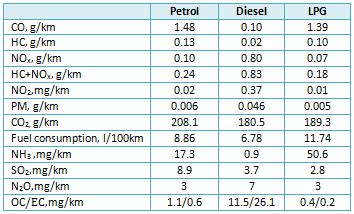
The above puts the facts into one easy to read table allowing us to quickly compare emissions and fuel economy of the three most common fuel types for an internal combustion engine passenger vehicle.
To prove the theory I have been successfully running my TVR Chimaera on clean burning LPG for almost six years now, in addition to the above reduction in emissions I also took great care to design my dual fuel installation as a zero compromise exercise:
The solution is here already, the real world immediate solution available to us all is LPG

More detail here:
https://www.pistonheads.com/gassing/topic.asp?h=0&...
- Fuel A being petrol
- Fuel B being low carbon LPG
LPG will dramatically lower tail pipe emissions, this due to chemistry, like diesel and petrol LPG is still a hydrocarbon (a mix of carbon and hydrogen atoms) but the difference is LPG only has 3 carbon atoms....... it's like this:
- Diesel = 9 Carbon Atoms
- Petrol = 7 Carbon Atoms
- LPG = 3 Carbon Atoms
- CNG = 1 Carbon Atom
- Pure Hydrogen = 0 Carbon Atoms

However and back to engines, it's important to acknowledge as the number of carbon atoms falls so does the calorific value of the fuel, this is one of the reasons diesel gives the best MPG, this along with the very high compression ratios used in compression ignition engines. Diesel is a very energy dense fuel but the pay off is more carbon atoms contained within the fuel the higher your tailpipe emissions will be.
What you need if you are genuinely considering reducing the emissions of a classic car of which I very much include the TVR Chimaera and Griffith models, is a fuel supported by a practical existing nationwide infrastructure of service stations, a fuel that also gives the best balance between calorific value and the number of carbon atoms it contains.
That really just leaves you with one truly practical fuel choice, LPG!

The above puts the facts into one easy to read table allowing us to quickly compare emissions and fuel economy of the three most common fuel types for an internal combustion engine passenger vehicle.
To prove the theory I have been successfully running my TVR Chimaera on clean burning LPG for almost six years now, in addition to the above reduction in emissions I also took great care to design my dual fuel installation as a zero compromise exercise:
- Retains a very practical 150 mile range on petrol
- Despite the lower calorific value I have an LPG range of 300+ miles to exactly match that of a petrol only Chimaera
- Minimal loss of luggage space while still holding the standard targa panel in the boot, I also have a Surrey top providing zero loss of luggage space and greater convenience
- Burning LPG the car now makes 10% more power than when it left Bristol Avenue on petrol back in 1996
- Smoother running and greatly improved drivability than any petrol Chimaera on the original Lucas 14CUX system and distributor
- Delivers the petrol cost equivalent of 50mpg when burning low carbon LPG at £0.55p a liter (£2.50 a gallon), that's just £0.11p a mile
- Extended oil change intervals, far cleaner engine internals and longer engine life due to the low carbon clean burning nature of LPG
- The car remains visually indistinguishable from a standard TVR Chimaera and sounds no different either
The solution is here already, the real world immediate solution available to us all is LPG


More detail here:
https://www.pistonheads.com/gassing/topic.asp?h=0&...
I don't know in the UK but in France we are starting to see more and more biofuel pumps (E85), and, on the paper, this is better than standard fuel (depending also if you have to import it from the other side of the planet or not).
For me the biggest drawback (biggest because it's maybe the only one) of LPG is the volume of the tank compared to the mpg.
For me the biggest drawback (biggest because it's maybe the only one) of LPG is the volume of the tank compared to the mpg.
Zeb74 said:
For me the biggest drawback (biggest because it's maybe the only one) of LPG is the volume of the tank compared to the mpg.
Now you see it...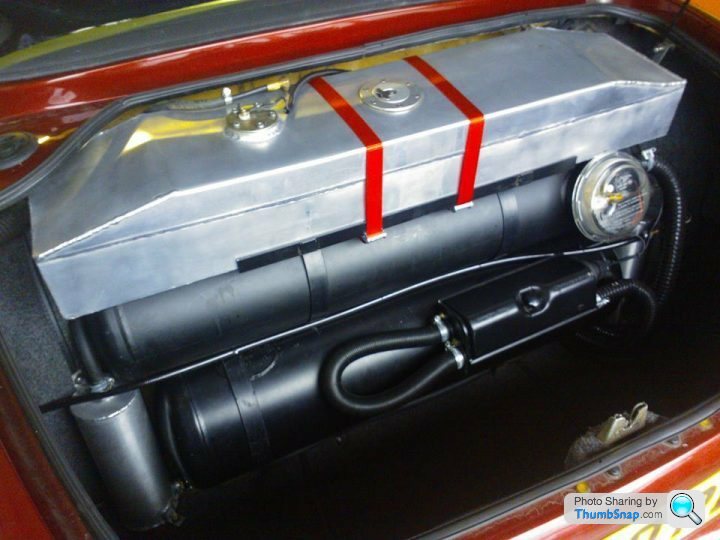
Now you don't.
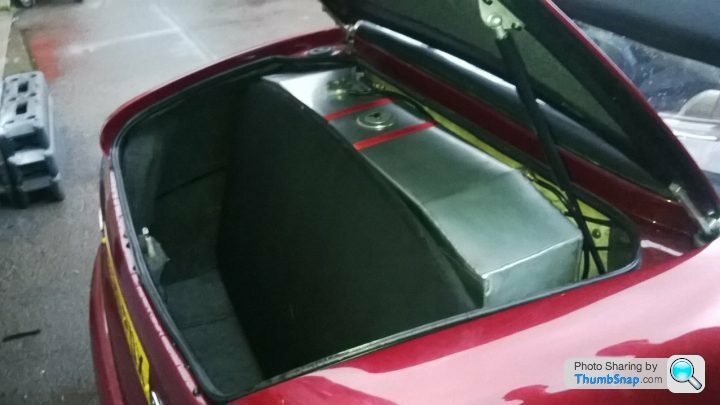
What you're looking at here is 150 miles of petrol, 300+ miles of LPG.... and over 95% of the already huge (for a sports car) boot space retained

Clearly you have done an amazing job here and it let us imagine what a fully integrated gaz tank would produce if car manufacturers were working on this. The ratio volume/range is much better than electric cars no?
I remember my father's Citroen ZX converted to LPG, the glove box was bigger than the remaining space in the boot (my brother had converted his 4 doors BMW 325ix, it was more convenient).
I remember my father's Citroen ZX converted to LPG, the glove box was bigger than the remaining space in the boot (my brother had converted his 4 doors BMW 325ix, it was more convenient).
Zeb74 said:
Clearly you have done an amazing job here and it let us imagine what a fully integrated gaz tank would produce if car manufacturers were working on this. The ratio volume/range is much better than electric cars no?
I remember my father's Citroen ZX converted to LPG, the glove box was bigger than the remaining space in the boot (my brother had converted his 4 doors BMW 325ix, it was more convenient).
Getting it right is all about careful packaging considering the available space, then doing your increased consumption sums. To be honest it's not rocket science, if you know from the outset car will deliver worse MPG on LPG by a certain percentage it stands to reason you'll need to carry more LPG by that same percentage if you wish to retain the vehicle's range.I remember my father's Citroen ZX converted to LPG, the glove box was bigger than the remaining space in the boot (my brother had converted his 4 doors BMW 325ix, it was more convenient).
A Chimaera has a 12.5 gallon petrol tank, but you may as well call it 12 gallons of usable fuel as you really don't want to be driving and relying on that last half a gallon, and it seems likely to me TVR designed the Chimaera to have a touring range of 300 miles. That is 300/12 = 25mpg, back in the day when my car was petrol only and running the Lucas 14CUX system/distributor I remember once stretching this range in ideal cruise conditions to 318 miles before I bottled it and pulled in to a station to brim the tank which took a fraction over 12 gallons.... so I was definitely running on the last knockings!!!!!!
When I designed my LPG conversion the idea was it was going to be a 'No-Compromise' exercise, if my TVR ran poorly on gas, made less power, lost lots of boot space, I couldn't get the standard roof panel in the boot, or the car's range was seriously reduced the project would have been a non-starter from the outset. This 'No-Compromise' approach demanded good planning and design, but the 300 mile range element of the brief while potentially very challenging really wasn't hard to work out at all

Chemically and in an ideal world LPG has a calorific value 18% lower than petrol, but when pressed most in the LPG conversion industry will admit to a 20 to 25% reduction in the car's average petrol MPG is far more realistic, so I took the standard car's 12 gallon petrol capacity and set an objective of holding 20% more usable gas. That's 12 x 1.2 = 14.4 gallons of usable LPG, I then needed to add a further 20% free space for LPG expansion on a hot day which is standard LPG conversion practice, this gave me a wet LPG tank capacity of 14.4 x 1.2 = 17.28 gallons or 78.55 litres which is quite a large tank I can tell you.
However, I didn't want to just fit one giant tank as that would have ruined my boot space and roof carrying objectives, I wanted to work with the shape of the Chimaera boot which if you study it is wide and deep, to do this I decided to stack two cylinders on on top of each other against the rear bulkhead where the original petrol tank went, then on top of that in what is effectively wasted space in the standard car I would fit a custom auxiliary petrol tank.
I was then restricted by whats commercially available in LPG tank sizes, the best fitting arrangement turned out to be one 200mm x 1052mm 30 litre cylinder laid horizontally on top of one 244mm x 966 42 litre horizontal cylinder. That gave me 30 + 42 = 72 litres wet capacity less the 20% for expansion = 57.6 litres so a full 21 litres short of my design brief
 . Unwilling to go bigger as this would have meant missing my boot space and quite possibly roof stowage expectations I needed to find a way of getting the figure of 57.6 litres up if I could do so safely, so I took the overly cautious 20% expansion figure and slashed it to 10%, this gave me 72 litres wet capacity less 10% = 64.8 litres or 14.25 gallons in old money.
. Unwilling to go bigger as this would have meant missing my boot space and quite possibly roof stowage expectations I needed to find a way of getting the figure of 57.6 litres up if I could do so safely, so I took the overly cautious 20% expansion figure and slashed it to 10%, this gave me 72 litres wet capacity less 10% = 64.8 litres or 14.25 gallons in old money.Having 10% expansion needed testing but studying the expansion of LPG rate over measured boot temps even on the hottest day gave me confidence it would be fine, its also worth remembering the expansion element only becomes and consideration in very hot weather and only then when the tank has just been brimmed, in my case the difference between 20% free space and 10% is just 7 litres or roughly a gallon and a half so within 30 miles or so of driving (half an hour in time) you're already back at the 20% free space figure anyway.
So now knowing I would hold a maximum of 64.8 litres (14.25 gallons) I could use this data to set my LPG fuel economy expectation to achieve may target range of 300 miles, that's 300/14.25 = 21 MPG which I felt was a realistic target to shoot for given LPG has an 18% lower calorific value, basically I was banking on the efficiency of the Canems system giving me an average of 26 MPG on petrol less the 18% = 21.32 MPG on gas.
As it turns out the car delivers even better LPG efficiency than I could have ever hoped for but did prove to take slightly less fuel at 64 litres (14.08 gallons), one balanced the other so what I ended up with was 22.54 MPG and a 14.08 gallon fill, which is 14.08 x 22.54 = 317.36 miles LPG range which very neatly matched my all tome standard 14CUX Chimaera best of 318 miles on petrol. The car does indeed deliver 26 MPG on petrol which itself is a very impressive average figure for a 4.0 litre Chimaera, but it's so efficient on LPG the drop in economy is not 25, 20 or even 18% it's a chemistry defying 10%!, which must make it one of the most efficient gaseous LPG conversions in the UK... if not the world.
In summary my 'No-Compromise' fuel range objective was met by:
1. Using maths

2. Safely chipping away at the overly cautious 20% free space rule a bit (I ended up with 11% free space and no issues)
3. The excellent efficiency of the dual Canems Dual Fuel system
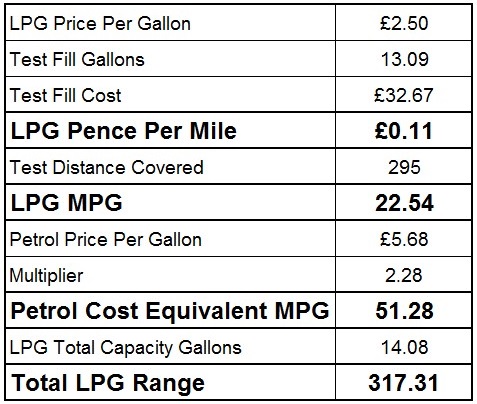
And all this while retaining 95% of the very capacious Chimaera boot space and still permitting me to put the standard roof panel in the boot and enjoy touring the continent for two weeks with lots of luggage for two.

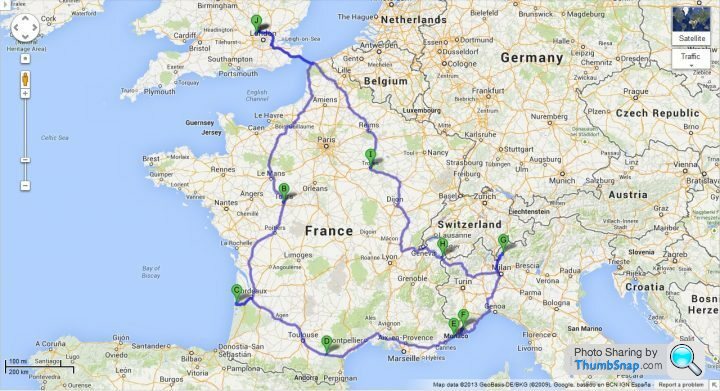
The secret to a good LPG is conversion outcome is no different to the process of designing anything, you absolutely must start with a clear design brief!
The rest is just using a calculator and a tape measure, planning everything out on paper, while rigidly following the design brief.... and all this before you even embark on the conversion

Gassing Station | Griffith | Top of Page | What's New | My Stuff






 like rockets
like rockets 